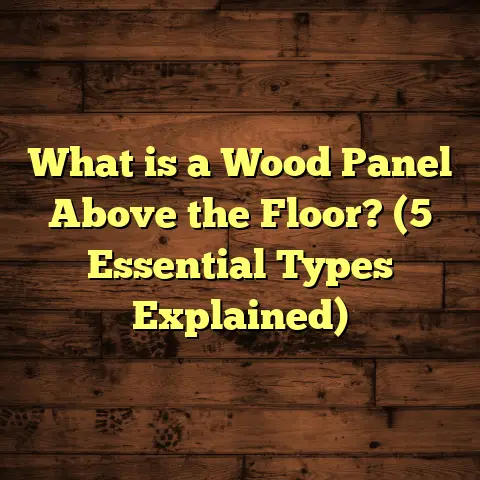What is a Solid Wood Floor? (5 Benefits for Your Home Design)
Would you rather invest in flooring that feels timeless
and authentic or opt for something that mimics the look
but lacks the soul? I’ve had many clients wrestle with this
question, and honestly, my answer often leans toward solid wood
floors. There’s just something about solid wood that brings warmth,
character, and a sense of home that other materials struggle to match.
What is a Solid Wood Floor?
A solid wood floor is exactly what it sounds like: flooring
made from a single piece of natural hardwood, milled from a
tree trunk. Unlike engineered hardwood, which is made by layering
wood veneers on top of plywood or other materials, solid wood
planks are crafted from one solid block of timber.
These floors typically come in thicknesses of 3/4 of an inch
(about 19 mm), making them sturdy and able to be sanded and
refinished multiple times over their lifetime. Common species
include oak, maple, cherry, walnut, ash, and hickory — each
offering unique grain patterns, color tones, and hardness levels.
When properly installed and cared for, solid wood floors can
last for generations. They possess a natural beauty that evolves
with time. The wood develops a patina — subtle changes in color
and texture — that gives each floor its own story.
I remember installing a solid oak floor in a client’s century-old
home. After sanding and finishing it on-site, the floor not only
restored the home’s character but also gave it a fresh, modern appeal.
That’s the beauty of solid wood: it blends history with today’s style effortlessly.
How Are Solid Wood Floors Made?
The process starts with carefully selecting logs from hardwood
trees. These logs are then cut into planks using different methods:
- Plain sawn (flat sawn): Produces wide grain patterns and is the
most common method due to less waste. - Quarter sawn: Yields straighter grain with a distinctive “ray” pattern,
more stable and less prone to cupping. - Rift sawn: Similar to quarter sawn but with a tighter grain pattern.
After cutting, the planks are dried (either air-dried or kiln-dried) to reduce moisture content.
This drying step is crucial because wood expands and contracts with humidity changes; proper drying helps prevent warping after installation.
Once dried, planks are milled to precise thickness and width. At this stage, manufacturers may pre-finish the boards with stains or protective coatings—or leave them unfinished for onsite finishing.
As someone who’s handled both pre-finished and unfinished installations, I can say that onsite finishing allows for better customization but takes longer and creates more dust during sanding. Pre-finished floors are quicker to install but offer fewer options for changing color later.
5 Benefits of Solid Wood Floors for Your Home Design
1. Timeless Beauty That Adds Value
One of the most talked-about advantages of solid wood flooring is its beauty. The natural grain patterns, subtle color variations, and texture create warmth and charm that no artificial material can truly replicate.
Have you ever walked into a room with hardwood floors and just felt at home? That’s not coincidence — it’s science and psychology working together.
Studies show natural materials like wood can increase feelings of comfort and wellbeing. A 2017 study published in Frontiers in Psychology found that exposure to natural materials in interiors reduces stress and promotes relaxation.
From a practical perspective, solid wood floors also add considerable value to your home. A Zillow report indicated homes with hardwood floors tend to sell faster and for about 2.2% higher prices than comparable homes without them.
I recall working with a couple who renovated their outdated condo by installing white oak flooring throughout the living areas. When it came time to sell two years later, they received multiple offers above asking price — many buyers specifically mentioned the floors as a major selling point.
The Character of Aging Wood
Unlike synthetic options that wear down or peel over time, solid wood ages gracefully — developing character through scratches, dents, and patinas that tell your home’s story.
For example, I saw a historic mansion where the original chestnut floors had been sanded only once in over 100 years. Those floors bore marks from generations but still looked stunning.
If you’re worried about scratches or dents from kids or pets, remember these imperfections add charm rather than detract from the floor’s appeal. Plus, refinishing your floor every 10-15 years restores its original beauty.
2. Durability That Stands the Test of Time
Solid wood floors aren’t just beautiful; they’re tough. Their thickness (usually 3/4 inch) means they can handle heavy foot traffic without losing integrity.
Wood hardness varies by species — the Janka hardness scale measures resistance to denting:
| Wood Species | Janka Hardness (lbs) |
|---|---|
| Red Oak | 1290 |
| Hard Maple | 1450 |
| Hickory | 1820 |
| Walnut | 1010 |
| Cherry | 950 |
This means hickory is much harder than walnut or cherry but softer than maple. Choosing a species depends on where you’ll install it; entryways or kitchens might benefit from harder woods.
In my experience, solid wood floors installed in busy commercial spaces have lasted decades with minimal damage. One restaurant I worked with had solid maple floors installed over 30 years ago—they still looked great after routine refinishing.
Repair and Refinishing
If your solid wood floor gets scratched or worn out, sanding it down and refinishing is possible multiple times. Depending on thickness, up to 10 refinishes can be done over its lifetime.
This ability is a game-changer compared to engineered hardwood or laminate floors, which have limited refinishing options due to their thinner wear layers.
I had a client who inherited an old Victorian home with worn pine floors. We sanded them down several times over 20 years, each time bringing back their rich honey color and making the floors look new again.
3. Eco-Friendly and Sustainable Choice
If reducing your environmental footprint matters to you (and it should), solid wood flooring is often a smart choice—especially if sourced responsibly.
Wood is renewable when harvested sustainably. Organizations like FSC (Forest Stewardship Council) certify forests managed with long-term sustainability in mind.
Choosing FSC-certified wood supports forest conservation and ensures no illegal logging occurs.
Also, solid wood floors have low embodied energy compared to synthetic materials like vinyl or laminate—which require petrochemical inputs during manufacturing.
At the end of their life cycle, solid wood floors are biodegradable or can even be repurposed into other wood products.
In recent years, I’ve noticed an uptick in clients requesting reclaimed wood flooring—old barn boards or salvaged hardwood—because they want unique floors with history plus environmental benefits by recycling material instead of cutting new trees.
4. Healthier Indoor Environment
Here’s one many overlook: solid wood flooring promotes better indoor air quality compared to carpets or some synthetic options.
Carpets trap dust mites, pet dander, pollen, and other allergens that can aggravate asthma or allergies. Sweeping or vacuuming only partially removes these irritants.
Solid wood floors don’t harbor allergens since they are easier to clean thoroughly by sweeping and mopping without harsh chemicals.
I worked with a family whose son suffered severe allergies; switching from wall-to-wall carpet to solid oak floors noticeably reduced his symptoms within months.
The Asthma and Allergy Foundation of America recommends hardwood floors as a healthier flooring choice for allergy sufferers or anyone looking to improve home air quality.
5. Customizable and Unique
One thing I love about solid wood floors is how customizable they are:
- You can pick from dozens of wood species.
- Choose plank widths ranging from narrow strips (2-3 inches) to wide planks (8-10 inches or more).
- Select finishes: matte, satin, semi-gloss, or high gloss.
- Stain colors vary from natural light tones to deep espresso and everything in between.
- Install patterns like straight planks, herringbone, chevron, or parquet designs.
Each plank has unique grain lines and knots—no two boards are exactly alike. This adds character you won’t find in mass-produced laminate or vinyl planks.
I remember helping a client design a modern rustic look by installing reclaimed chestnut wide-plank floors with a matte finish; it completely transformed their open concept space into something cozy yet contemporary.
Installation Considerations for Solid Wood Floors
Installing solid wood flooring requires specific attention compared to other types:
- Acclimation: Before installation, planks must be stored on-site for several days (usually 5–7) so they adjust to local humidity levels.
- Subfloor preparation: The subfloor must be flat, clean, dry, and structurally sound.
- Nailing/Stapling: Solid wood is commonly nailed or stapled down over plywood subfloors.
- Expansion gaps: Because wood expands/contracts with humidity changes, installers leave small gaps around walls to prevent buckling.
- Finishing: If unfinished boards are used, sanding and finishing happen onsite after installation.
Improper installation can cause issues like cupping (boards arching upwards), gapping between planks during dry seasons, or squeaking sounds underfoot.
Over the years I’ve learned that working with experienced installers who understand how wood behaves is critical for a long-lasting floor.
Maintenance Tips for Longevity
Solid wood floors require some care but aren’t high maintenance if you follow simple guidelines:
- Sweep or vacuum regularly to remove dirt/grit that can scratch surfaces.
- Use soft mop dampened with cleaner designed for hardwood floors.
- Avoid excessive water; standing water damages wood.
- Place felt pads under furniture legs.
- Quickly clean spills to prevent stains.
- Refinish every 10–15 years depending on wear.
- Control indoor humidity between 35–55% to minimize expansion/contraction problems.
I always advise clients that investing a little time regularly saves big headaches later on costly repairs or premature replacement.
Real-Life Case Study: Solid Wood Floors in Action
Let me share one project example from my portfolio—it captures why I’m passionate about solid wood flooring.
A young family bought an early 1900s Craftsman bungalow needing full renovation. The original pine floors were severely damaged but still salvageable. We carefully removed old carpet and refinished those pine planks onsite.
The result? The warm amber tones combined with subtle grain patterns created an inviting environment perfect for their growing kids’ active lifestyle.
They told me how much they loved walking barefoot on those floors every day—“It feels like the house has its own heartbeat,” they said.
Furthermore, thanks to the thickness of those pine boards (3/4 inch), we anticipate sanding them down at least twice more over the next few decades before replacement will be needed—making it an investment that truly lasts.
Comparing Solid Wood Floors With Other Popular Options
Let’s break down how solid wood stands against alternatives:
| Flooring Type | Durability | Maintenance | Cost per sq.ft* | Lifespan | Aesthetic Appeal |
|---|---|---|---|---|---|
| Solid Wood | High (Refinishable) | Moderate (Refinishing needed over time) | $6 – $12 | 50+ years up to 100+ | Natural beauty & warmth |
| Engineered Hardwood | Moderate | Low | $4 – $9 | 20-30 years | Similar to solid wood |
| Laminate | Low | Low | $1 – $4 | 10-20 years | Imitates wood |
| Vinyl Plank | Low | Low | $2 – $7 | 10-20 years | Various styles available |
| Carpet | Low | High (Frequent cleaning) | $2 – $5 | 5-15 years | Wide range of textures |
*Prices vary by region and quality level
Engineered Hardwood vs Solid Wood
Engineered hardwood uses thin layers of real wood over plywood cores—making it less expensive and more resistant to moisture changes but limiting refinishing options.
Ideal for basements or humid climates where solid wood might warp easily due to moisture fluctuations.
Laminate vs Solid Wood
Laminate is made of fiberboard core topped with photographic images of wood grain under clear protective layers.
It’s budget-friendly but cannot be refinished; damage means replacing whole boards. Also lacks the warmth and authenticity of real wood.
Vinyl Plank vs Solid Wood
Vinyl plank is waterproof synthetic flooring styled like hardwood but lacks real grain texture or aging qualities. Best suited for moisture-prone areas like bathrooms but doesn’t add resale value compared to real wood.
Carpet vs Solid Wood
Carpet offers softness underfoot but traps allergens and stains more easily than hard surfaces. It needs frequent cleaning and replacement every few years.
Solid wood’s easy cleaning and allergen resistance give it an edge here.
Solid wood flooring is more than just a surface—it’s an investment in beauty, durability, health, and sustainability that pays off for decades. If you ask me about flooring choices for a home you want to cherish forever, my answer almost always points toward solid wood as the best long-term solution.
Have you considered how your flooring will look not just now but in twenty or fifty years? Solid wood ages like fine wine—it gets better with time. And having installed hundreds of these floors myself across all kinds of homes, I can tell you: nothing else comes close when you want authenticity you can feel beneath your feet every day.
If you want help figuring out what species fits your style or how to maintain your investment properly—ask away! I’m here to share everything I’ve learned so your floor becomes one of your home’s greatest features for generations ahead.





